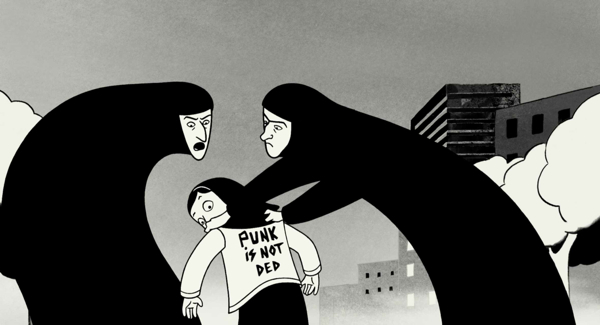Movie review by Greg Carlson
Marjane Satrapi’s four volume graphic novel memoir “Persepolis” comes to life in beautifully rendered animation in the Academy Award-nominated movie of the same name. Recounting the author’s journey from childhood to young adulthood, “Persepolis” will offer the majority of its American viewers the rare opportunity to peek inside a largely unknown world of experiences. In addition to its memorable design, which breathes stark, expressionistic life into Satrapi’s drawings, the movie neatly balances coming-of-age themes common to all cultures with the particularity of the social and political upheaval of the Islamic Revolution.
The story commences in Tehran in the late 1970s, as Marjane’s progressive family watches in fear as the Shah’s monarchy crumbles under Khomeini. As one repressive system yields to something even more frightening, Marjane (voiced as a kid by Gabrielle Lopes) takes things in stride, mostly trusting the word of her family, skeptically challenging her teachers at school, and ignorantly acting out with a group of friends. Satrapi, who co-wrote the adaptation and co-directed the movie with comics artist Vincent Paronnaud, stuffs the frame with all kinds of humorous detail, including her own mania for pop music. Acquired on the black market, the cassette tapes Marjane adds to her collection include an eclectic range of performers: ABBA and the Bee Gees vie with Michael Jackson and Iron Maiden.
Once the Iran-Iraq War commences, Marjane’s parents send her to the French Lycee of Vienna, and the separation leaves a lasting impression on the youngster as she struggles through puberty. In terms of plot, “Persepolis” adopts a linear, episodic chronology, but Satrapi infuses the narrative with her ever-changing personal philosophy, made all the more impressive by the author’s healthy dose of self-deprecation. As Marjane explores a range of ideologies, including nihilistic and existential leanings that feed into her anger and depression, the movie retains a refreshing honesty about the changes one undergoes on the path to maturity.
“Persepolis” includes a few brief color sequences, but the majority of the movie unspools in elegant black and white. Despite the film’s computer assisted enhancements, the traditional 2D, hand-drawn work, which was completed on paper and then felt-tip inked by a team of artists, immediately evokes an unmistakable warmth that cannot be replicated by software. Animation enthusiasts will positively swoon at the craftsmanship of the feature, and it is a safe bet to suggest “Persepolis” will be scrutinized by animators interested in alternatives to the dominance of 3D modeling and graphics programs like Maya. At times, “Persepolis” nods to animation history, with cutout-style moments that recall seminal work like Lotte Reiniger’s “The Adventures of Prince Achmed.”
Not too surprisingly, the Iranian government has voiced displeasure at “Persepolis,” and made a successful bid to have the movie withdrawn from the Bangkok International Film Festival. A few screenings of “Persepolis” have taken place publicly in Tehran, although according to the Middle East Times, a number of scenes were censored before the showings received the go-ahead. Viewers in the United States might take the privilege of criticizing their political leaders for granted, but “Persepolis” hardly strikes one as anti-Iranian. If anything, it aches with the central character’s longing and love for her homeland, even as she lives in exile.
